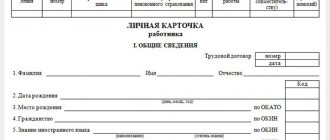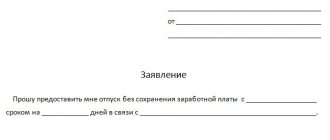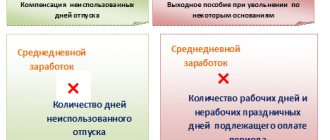Which form to use
The calculation note (form No. T-61) is a primary accounting document.
It was approved by Decree of the State Statistics Committee of the Russian Federation No. 1 of 01/05/2004 and is intended to calculate wages and other payments to an employee upon termination of an employment contract. An employer is not required to use Form T-61 when dismissing employees. It is advisory and convenient in that personnel and accounting programs already contain a unified T-61 form. But it is allowed to develop your own form of calculation note to take into account the characteristics of the organization. Use the T-61 as a base, it will simplify the task.
Who fills out the calculation note
The calculation note is a two-sided register with an introductory part and a calculation table. The form is filled out by responsible personnel and accounting employees. The personnel officer indicates the proper information about the company and the dismissed employee on the front side, the accountant fills out the columns of the tabular part on the back side.
The calculation note is drawn up on the basis of the necessary documents (statements, payment and settlement documents, which reflect all accruals for the billing period).
How long before dismissal should you write a note?
The legislation does not regulate the period of time during which a settlement note must be drawn up. The norms of the acts only establish the obligation to pay all money due upon dismissal to the employee either on the final day of work, or, if the salary is transferred to the card, then on the next day.
The deadline for its formation is the final working day of the resigning employee. If the employee terminates the contract on his own initiative, then according to the general rules he submits an application two weeks before this date.
This is important to know: Is it possible to fire someone for being late for work?
Therefore, you can issue a dismissal order and draw up a settlement note from the moment you receive the dismissal application. However, you must also remember the employee’s right to withdraw the application before the end of the notice period. Therefore, the dismissal order and the note may have to be canceled.
How to fill out a note-calculation
Let's look at step by step how to fill out a settlement note upon dismissal.
Step 1. Fill out the front side.
Here the personnel officer indicates:
- full or short name of the organization and its code in accordance with OKPO;
- details of the note itself - document number and date of completion;
- information about the employment contract with the dismissed employee - its number and date of conclusion.
Enter the employee's personnel details:
- last name, first name and patronymic;
- Personnel Number;
- department or structural unit.
Please provide your resignation details below:
- basis in accordance with the Labor Code of the Russian Federation;
- order details;
- date of termination of the employment agreement.
All that remains is to enter the number of unused or advance vacation days.
After entering all the data, the responsible HR employee certifies the front side of the calculation note with a signature.
Step 2. Fill out the back side.
The reverse side consists of four tables in which the accountant calculates vacation pay and calculates compensation.
The first table includes the year of the billing period (column 1) and the calendar months of the reporting year preceding the date of dismissal (column 2). The lines corresponding to each month (column 3) reflect the total amounts of payments to the employee.
The second table of the calculation note reflects the total number of calendar days in the accounting year. Use a production calendar or calculate the number of days based on a conditional average. If the employee worked the entire month, then the number of calendar days will be 29.3.
If the month is not fully worked out, then the number of days is calculated as follows:
(29.3 / total number of days in the reporting month) × number of days actually worked according to the time sheet.
If an employee receives a salary for hours actually worked, then a special column in table No. 2 is filled in.
Now calculate your average daily earnings using the formula:
Average daily earnings = total amount of accruals for the billing period / total number of calendar days (hours).
Information about unused or advance-used vacation is entered into the last table of the calculation note, and then the amount of vacation pay to be paid or the amount of deductions that are made is calculated.
Step 3. Calculation of final payments in the note.
At the end, all calculated data is accumulated and the amount of compensation is calculated. The accountant must enter:
- wages for the reporting month;
- vacation pay (from the previous table);
- other charges;
- the total amount of accrued payments;
- estimated personal income tax on all charges;
- other types of deductions (if any);
- total for all types of deductions;
- debt of an organization to an employee or an employee to a company.
When all amounts are indicated, the final amount of payment to the employee upon dismissal is calculated. Then the same amount is written down in numbers and words. The accountant enters the details of the payroll, on the basis of which the employee received the appropriate funds. The accountant responsible for calculating compensation signs the table.
Note on dismissal
According to the norms of the Labor Code, each employee upon dismissal from the enterprise is entitled to certain compensation payments. Such payments may include:
- wages for days worked from the moment of submitting your resignation until the final day of work;
- payments for days of accrued but not compensatory vacation;
- severance pay provided for by various articles of the Labor Code of the Russian Federation or a specific employment contract.
In each case, the amount of payments is determined individually, in accordance with the working conditions of a particular employee. The total amount to be paid is indicated in a document called a settlement note. At the request of the resigning employee, this document can be issued to him on the final working day along with the work book and other papers.
The personal experience of the author of this material suggests that you should not neglect the opportunity to receive a properly certified settlement note from your employer. The author has had the opportunity to participate in interviews of candidates for various positions more than once. One day the conversation turned to determining the level of future wages for one of the candidates. The amount requested by the applicant seemed prohibitively high to the HR manager. The candidate prepared in advance for such a development of events and showed us a note-account from his previous place of work, the contents of which confirmed the fairness of his salary claims. The moral of this story is that even in our age of widespread computerization and informatization, it is better to have documents at hand and in paper form.
Video: main stages of dismissal
Features of filling out a note-calculation
Here are the key rules, use them as a reminder:
- The front part of the form contains information about the employee, the grounds for hiring and termination of the employment contract. First, the HR department indicates the date of conclusion and number of the employment contract, full name. employee, his position, department. Then he puts the date of the dismissal order, its number, the basis for termination of the employment relationship, establishes the number of days of unused vacation for calculating compensation or, if the employee took vacation in advance, the amount of days used to make deductions. Signs the first page. Then the calculation note is transferred to the accounting department.
- The reverse side contains information for payment of vacation pay, information about wages and other payments for the period and the final amounts due to the employee. To do this, take a period of 12 months before the month of dismissal and all payments made to the employee during this time.
- After filling out all the columns, the accountant certifies the calculation note with a signature and passes it on for accrual of the amounts due.
- The calculator processes the information received and enters it into the appropriate columns of the form regarding charges and payments. Then it determines the amount of average daily earnings and the amount of compensation or the amount of the employee’s debt due for repayment. The calculation of compensation is determined by multiplying unused days by average daily earnings.
- In addition to compensation, wages are calculated for time worked. All accruals and deductions are reflected in the pay slip, which is issued to the employee, and payment documents for the payment of these amounts are transferred to the appropriate accounting specialist.
Filling rules
A unified form of the document is not established by law, therefore each employer can develop its own form of the form and establish the procedure for its issuance, taking into account the norms of the Labor Code of the Russian Federation. The issuance procedure is fixed in the local regulations of the organization, indicating the persons responsible for the issuance.
This is important to know: What to do if you are laid off at work
The legislation does not say in what form the document should be issued. This can be a standard A4 sheet or company letterhead. The sheet can be filled out either handwritten or printed. The pay slip must not contain typos or false information, otherwise the document will be declared invalid.
An accounting department employee is appointed responsible for the formation of the payslip, since he has access to information about payroll for each employee. Since the payslip is only an information document, it does not require the signature of the manager and the seal of the enterprise.
You can hand over a payment document to an employee with or without a signature (what papers must the employee sign?). The first option is more reliable, since the employer can document the receipt by the employee of the sheet at any time. To implement it, choose one of the following methods:
- tear-off spine - upon receipt, the employee puts a personal signature on the tear-off part of the form, after which the spine remains with the employer;
- keeping a journal - upon receipt of a document, employees sign in the journal for issuing pay slips;
- an additional column in payment documents or a separate form where employees sign upon receipt of the document.
An employer may fulfill its obligation to inform staff, but not document this fact. This applies to the following cases:
- employees are informed about the issuance of pay slips, but they apply for the document themselves when necessary, for example, upon dismissal;
- information is provided by sending data by email;
- information is posted in the employee’s personal account on the corporate website (in case of dismissal, it may not be applied due to the employee’s access being blocked).







